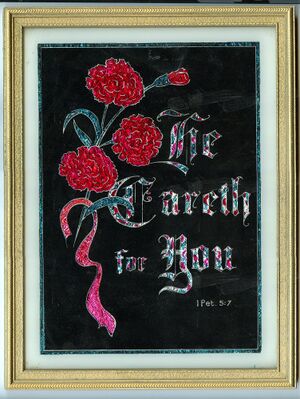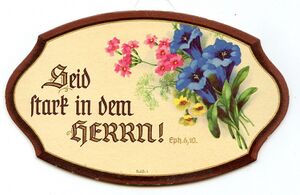Wall Mottos (Wandsprüche)

Photo: MAID Mennonite Heritage Archives (671-04)

Wall Mottos, sometimes called wall sayings and known in German as: Wandsprüche, are short texts usually of Bible verses, and sometimes of proverbs or wise saying that were set into a picture type frame and mounted on a wall in a Mennonite home. Some are embroidered but most are made of paperboard, or wood or glass or metal and sometimes with decorative ornaments or set in a picture frame. Many were commercially produced but some were individually and artistically created and those can be considered a form of Folk Art as described by Ervin Beck. In most conservative Amish and Mennonite homes they were the only form of wall decoration because the mounting photographs or pictures were thought of as a vanity and a violation of Exodus 20:4.
In the Reformation movements Anabaptist and Calvinist were iconoclastic and worked to remove all pictures, icons and monuments from their places of worship. Thus, their Church buildings and as a consequence also their homes were simple and unadorned. Mennonites all through their history were literate people and preferred to contemplate on Bible texts rather than pictures. Mennonite homes in Russia were also known to mount some forms of these Wall Mottos. The more elaborate glass form of these Wall Mottos in Mennonite homes in the early 20th century Russia are seen in photographs on page 25 of the book Als Ihre Zeit Erfüllt War, by Quiring, Walter and Helen Bartel.
From the middle of the nineteenth to the twentieth century Wall Mottos also became popular to the general public in Europe and America and were produced in different languages and formats. In the United States and Ontario where Mennonites in those years favoured the English language, they placed on their walls English language forms of Wall Sayings. For example, many forms of these are seen listed for sale on 10 pages of the 1923-24 Catalog of the Mennonite Publishing House (Scottdale, Penna.). In Amish or conservative Mennonite homes where the German language was spoken, as for example in the homes of Old Colony Mennonites on the Canadian prairies, these Walls Sayings in German were often found. The 1934 catalogue of the Deutsches Buch- und Musikgeselschäft (Winnipeg, Manitoba) list three pages of a variety of these Wandsprüche. The price of the Wall Mottos in these catalogues ranged from 10-50¢ each. Printers first produced them in large quantities on paperboard and then in the 20th century many small businesses began manufacturing then in modest decorative forms on wood, metal or glass. Beginning in about the 1920s some Mennonite churches began adding a popular Bible verse to the front wall of their sanctuary. Those congregations using the German language had these words always in lettered in Fraktur type German and English language congregations used Roman lettering.
From the 1920s to 1950s in private Mennonite schools, in youth groups and occasionally an inspired individual would gather materials and work individually or in groups to craft their own Wall Mottos. Ervin Beck describes the creations by several highly skilled Amish craftworkers. The Commercially made ones or these individually crafted Wall Mottos were given as gifts at baptisms, anniversaries or at weddings. In the last part of the twentieth century and as Mennonite Churches and their members integrated more into their national societies and also transitioned from the German language to English the use of Wall Mottos fell into disfavour though as an art form they were still revered.
Bibliography
Beck, Ervin. "Mennonite and Amish Painting on Glass." Mennonite Quarterly Review. Vol. 63, no. 1, April 1989. pp. 115-149.
Brednich, Rolf, Mennonite Folklife And Folklore : A Preliminary Report. Canadian Centre for Folk Culture Studies. Ottawa, Ontario. 1977. 116 pages
Deutsche Bücher Wegweisser für Bücherfreund: Winnipeg, Manitoba. Deutsches Buch- und Musikgeschäft. [1934], 128 pages.
Quiring, Walter and Helen Bartel. Als ihre Zeit erfüllt war : 150 Jahre Bewährung in Russland. Saskatoon, Saskatchewan, Modern Press, 1964, 211 pages. See page 25.
Quiring, Walter and Helen Bartel. Mennonites in Canada: A Pictorial Review. Altona, Manitoba. D. W. Friesen & Sons Ltd. 1961. See pictorial examples on pages 64, 97, and 190.
| Author(s) | Victor G Wiebe |
|---|---|
| Date Published | 22 February 2024 |
Cite This Article
MLA style
Wiebe, Victor G. "Wall Mottos (Wandsprüche)." Global Anabaptist Mennonite Encyclopedia Online. 22 February 2024. Web. 21 Nov 2024. https://gameo.org/index.php?title=Wall_Mottos_(Wandspr%C3%BCche)&oldid=178340.
APA style
Wiebe, Victor G. (22 February 2024). Wall Mottos (Wandsprüche). Global Anabaptist Mennonite Encyclopedia Online. Retrieved 21 November 2024, from https://gameo.org/index.php?title=Wall_Mottos_(Wandspr%C3%BCche)&oldid=178340.
©1996-2024 by the Global Anabaptist Mennonite Encyclopedia Online. All rights reserved.

